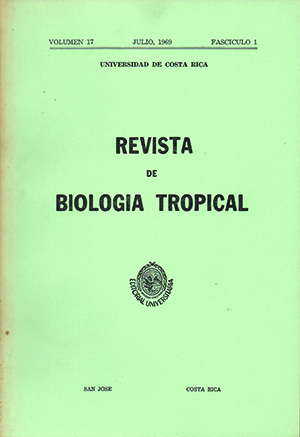Resumen
Se describe la morfología del huevecillo y estadíos ninfales de Porocephalus stilesi y los huevecillos de P. clavatus en búsqueda de caracteres diferenciales que puedan ser usados para separar estas dos especies entre sí, así como éstas de P. crotali.
Los huevecillos de P. stilesi fueron obtenidos de hembras encontradas en Lachesis muta muta; los de P. clavatus de hembras provenientes de Boa constrictor imperator; ambos reptiles de Costa Rica.
El estudio de las estructuras se hizo con huevecillos intactos así como mediante la disección del embrión.
Para estudiar los estadíos ninfales de P. stilesi se dieron, mediante vía oral, huevecillos maduros a ratas albinas, machos. Las ratas fueron disecadas y los distintos órganos colocados en agua, y revisados por formas encapsuladas. Las cápsulas se separaron de los tejidos adyacentes, y las ninfas disecadas de sus cápsulas. Las ninfas se fijaron y luego se montaron en forma total o sólo algunas de sus partes.
El estudio del huevecillo incluyó las siguientes estructuras: membranas, faceta, órgano dorsal, aparato penetrador, armadura oral, patas y cola. Se tomaron medidas de todas las estructuras mencionadas en las dos especies y fueron comparadas estadísticamente, con P. crotali. También se hicieron algunas observaciones sobre la actividad del embrión.
En el estudio morfológico de los seis estadíos ninfales de P. stilesi se tomaron medidas de longitud y anchura del cuerpo, armadura bucal, ganchos, anillos del cuerpo y número de pseudosegmentos. Se da información sobre los períodos requeridos para la aparición de los distintos estadíos ninfales a partir de la ingestión de los huevecillos.
Se incluyen fotografías que muestran todas las estructuras descritas y estudiadas, tanto para los huevecillos, como para los estadíos ninfales.
Las diferencias entre las medidas de las tres combinaciones posibles, P. crolati-P. stitesi, P. crotali-P. clavatus y P. stilesi-P. clavatus, fueron significativas al 5 % para las siguientes estructuras del huevecillo: envoltura externa (diámetro menor), cáscara externa (diámetro menor), longitud del cuerpo, longitud de la cola y barra transversal de la armadura bucal.
Asimismo las pruebas de significancia al 5 % para las diferencias entre las medidas de las ninfas de P. crotali y P. stilesi fueron significativas para el ancho del cuerpo de los estadíos I y VI Y para la longitud de los seis estadíos ninfales; también para la longitud del anillo oral de todos los estadíos excepto la ninfa VI y para el ancho del anillo bucal excepto el de la. ninfa V.
Debido a que las tres especies de Porocephalus estudiadas provinieron de diferentes regiones y huéspedes, es muy posible que las diferencias encontradas sean debidas a factores tales como distribución geográfica, huéspedes, plasticidad del embrión y ninfa, edad de los huevecillos y ninfas, diferencias en las técnicas de fijación, variaciones en la preparación y observación de los especímenes y a las muestras de distintas hembras de Porocephalus.
Ni el análisis estadístico ni el morfológico dieron caracteres adecuados que pudieran ser usados para separar estas llamadas especies de Porocephalus satisfactoriamente.


